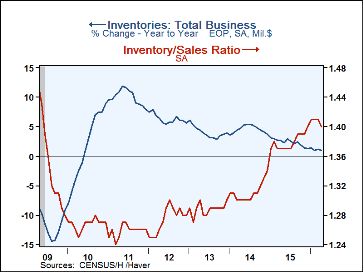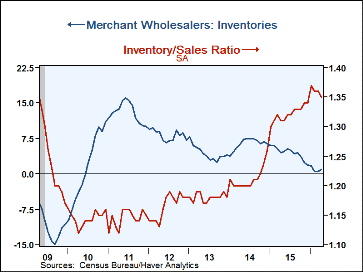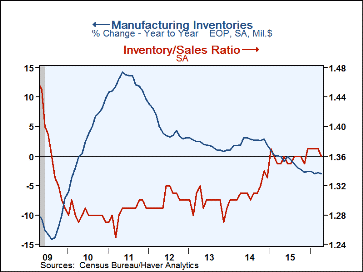 Global| Jun 14 2016
Global| Jun 14 2016Business Inventories Weaker in April, But Sales Jump
by:Sandy Batten
|in:Economy in Brief
Summary
Total business inventories inched up 0.1% m/m (1.0% y/y) in April following a 0.3% m/m increase in March (revised down from 0.4% m/m). Total business sales jumped 0.9% m/m (-1.3% y/y) in April after a 0.2% m/m rise in March (revised [...]
Total business inventories inched up 0.1% m/m (1.0% y/y) in April following a 0.3% m/m increase in March (revised down from 0.4% m/m). Total business sales jumped 0.9% m/m (-1.3% y/y) in April after a 0.2% m/m rise in March (revised from 0.3%). The April sales increase was the largest monthly gain since February 2014.
The new information in today's release was for retail inventories. Manufacturing and wholesale inventories had already been reported. Manufacturing inventories were down 0.1% in April (their tenth consecutive monthly decline) while wholesale inventories were up 0.6% m/m, their second consecutive monthly increase following five consecutive monthly declines.
Retail inventories unexpectedly slipped 0.1% m/m in April after having posted gains in each of the ten preceding months. Recent increases had been substantial-0.9% m/m in March and 0.7% m/m in February. In April, retail inventories excluding motor vehicles and parts fell 0.2% m/m with widespread declines across major categories. Furniture inventories fell 0.5% m/m. Building materials inventories were down 0.2% m/m. And inventories of general merchandise stores declined 0.5% m/m.
Sales were up across all sectors in April. Retail sales jumped 1.4% m/m (up 0.9% m/m when motor vehicles are excluded). Wholesale sales climbed 1.0% m/m in April, their second consecutive significant increase after four consecutive monthly declines. Manufacturing sales were up 0.5% m/m in April, their second consecutive monthly increase following three consecutive monthly declines.
The inventory-to-sales ratio in the business sector edged down to 1.40 in April from 1.41 in February and March. The February/March reading had been the highest since the economy exited recession in 2009. Inventory-to-sales ratios also retreated slightly in each of the individual sectors-again from levels that were the highest in the current economic expansion.
The manufacturing and trade data are in Haver's USECON database.
| Manufacturing & Trade | Apr | Mar | Feb | Apr Y/Y | 2015 | 2014 | 2013 |
|---|---|---|---|---|---|---|---|
| Business Inventories (% chg) | 0.1 | 0.3 | -0.1 | 1.0 | 1.3 | 3.7 | 3.9 |
| Retail | -0.1 | 0.9 | 0.7 | 5.4 | 5.3 | 3.1 | 7.4 |
| Retail excl. Motor Vehicles | -0.2 | 0.1 | 0.2 | 2.8 | 4.1 | 2.6 | 4.8 |
| Merchant Wholesalers | 0.6 | 0.2 | -0.6 | 0.9 | 1.9 | 6.5 | 4.0 |
| Manufacturing | -0.1 | -0.1 | -0.4 | -3.0 | -2.6 | 1.8 | 1.0 |
| Business Sales (% chg) | |||||||
| Total | 0.9 | 0.2 | -0.3 | -1.3 | -2.6 | 2.8 | 2.9 |
| Retail | 1.4 | -0.3 | 0.0 | 2.6 | 1.6 | 3.9 | 3.8 |
| Retail excl. Motor Vehicles | 0.9 | 0.5 | -0.1 | 2.5 | 0.2 | 3.2 | 2.6 |
| Merchant Wholesalers | 1.0 | 0.6 | -0.2 | -2.6 | -4.3 | 3.6 | 3.1 |
| Manufacturing | 0.5 | 0.3 | -0.6 | -3.4 | -4.4 | 1.2 | 2.1 |
| I/S Ratio | |||||||
| Total | 1.40 | 1.41 | 1.41 | 1.37 | 1.38 | 1.31 | 1.29 |
| Retail | 1.50 | 1.52 | 1.50 | 1.46 | 1.46 | 1.43 | 1.41 |
| Retail excl. Motor Vehicles | 1.28 | 1.29 | 1.30 | 1.27 | 1.27 | 1.24 | 1.23 |
| Merchant Wholesalers | 1.35 | 1.36 | 1.36 | 1.31 | 1.32 | 1.21 | 1.18 |
| Manufacturing | 1.36 | 1.37 | 1.37 | 1.35 | 1.36 | 1.31 | 1.30 |
Sandy Batten
AuthorMore in Author Profile »Sandy Batten has more than 30 years of experience analyzing industrial economies and financial markets and a wide range of experience across the financial services sector, government, and academia. Before joining Haver Analytics, Sandy was a Vice President and Senior Economist at Citibank; Senior Credit Market Analyst at CDC Investment Management, Managing Director at Bear Stearns, and Executive Director at JPMorgan. In 2008, Sandy was named the most accurate US forecaster by the National Association for Business Economics. He is a member of the New York Forecasters Club, NABE, and the American Economic Association. Prior to his time in the financial services sector, Sandy was a Research Officer at the Federal Reserve Bank of St. Louis, Senior Staff Economist on the President’s Council of Economic Advisors, Deputy Assistant Secretary for Economic Policy at the US Treasury, and Economist at the International Monetary Fund. Sandy has taught economics at St. Louis University, Denison University, and Muskingun College. He has published numerous peer-reviewed articles in a wide range of academic publications. He has a B.A. in economics from the University of Richmond and a M.A. and Ph.D. in economics from The Ohio State University.










